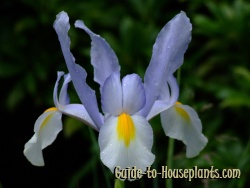





Botanical Name: Iridaceae x hollandica
Dutch iris bulbs demand two things to grow and bloom well: sunshine and good drainage. If you have a sunny window, you can easily grow these magnificent flowers in your home.
Unlike the most irises, Dutch irises grow from bulbs, not rhizomes, making them an excellent choice for forcing.
Tall, upright stems and silky, delicate blooms lend elegant beauty wherever you display them. The flowers can grow up to 4 inches (10 cm) across are available in a rich rainbow of colors -- blue, violet, white, yellow and bicolors.
Dutch irises need a cold treatment for 8 weeks. Start the process in October or November for mid-winter blooms.
 Origin: These hybrids are bred in the Netherlands and are a cross between Spanish and African irises
Origin: These hybrids are bred in the Netherlands and are a cross between Spanish and African irises
Height: Up to 24 in (60 cm)
Light: Keep in a dark location during cold treatment. Cover pot with a box, pot or black garbage bag if necessary. After shoots appear, move to bright light with some direct sun as directed above.
Water: Water sparingly until growth appears, then water enough to keep soil evenly moist. Soggy soil will cause bulbs to rot.
Humidity: Average room humidity.
Temperature: After the cold treatment, cool to average 60-65°F/10-18°C
Soil: Any good potting mix.
Fertilizer: Feed monthly with a balanced liquid fertilizer diluted by half from planting until start of blooming. Do not fertilize while plants are in bloom.
Propagation: Irises cannot be forced a second time indoors. If you want to keep them, allow the foliage to die back naturally, then store them in a cool, dry place. Plant the bulbs in a sunny spot in your flower garden in the fall. Dutch irises are hardy to Zone 5 and naturally bloom in early summer. Dutch iris bulbs multiply rapidly, so you'll enjoy a profusion of these captivating irises.
Copyright © www.100flowers.win Botanic Garden All Rights Reserved